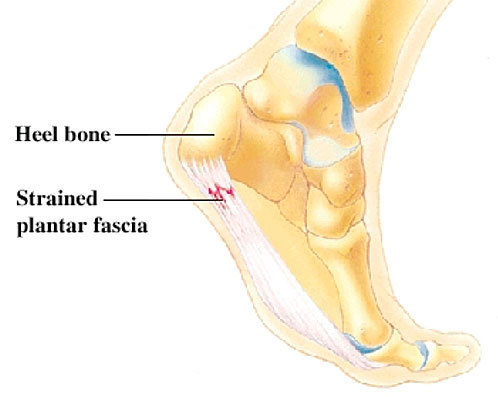What is plantar fasciitis?

Plantar fasciitis is pain on the inside aspect of the heel. It is usually an overuse injury that causes inflammation of the plantar fascia at its attachment site on the heel bone.
How does plantar fasciitis happen?
Plantar fasciitis occurs as a result of stretching or ‘pulling’ of the plantar fascia from its attachment on the heel bone. Activities such as running and dancing are commonly associated with the development of plantar fasciitis. This injury is called an overuse injury; it may happen over a long period of time before the patient decides to seek treatment.
How does it feel to have plantar fasciitis?
The pain is typically worse in the morning, with the first steps being very tender until the area warms up. Pain is worse with high impact weight-bearing activities. The site of tenderness is localized to the inside aspect of the heel, and is usually described as a dull ache. Over time, combined with the repetitive nature of running or walking, the inflammation can get worse and the intensity of the pain increases.
What should you do if you have plantar fasciitis?
If you have or suspect you have plantar fasciitis then you should seek treatment as soon as possible with one of our podiatrists. The earlier this injury is treated, the more successful the outcomes. Conservative management is indicated in the form of ice, massage, stretching, footwear modification, heel cushioning and foot orthoses.
What shouldn't you do if you have plantar fasciitis?
You shouldn’t put up with the pain in the hope it will go away. The injury is deceptive in that it warms up and you are able to walk and run on the area. Unfortunately each time you run on it you are causing more problems. With time, the pain will not warm up and your injury is far harder to treat, and may take longer to respond to conservative treatment.
Could there be any long-term effects of having plantar fasciitis?
There could be long-term problems with chronic pain in the area. A heel spur can develop secondary to the plantar fasciitis. More importantly, however, the inflammation can become chronic and may require an injection of cortisone (anti-inflammatory drug), or a surgical opinion.
Management of plantar fasciitis
Sports podiatry assistance is important in the diagnosis and management of plantar fasciitis. An accurate diagnosis is necessary to ensure successful management outcomes. This may include radiological examinations, either X-ray or ultrasound. It is important to rule out other possible differential diagnoses which affect this area of the heel. Once the extent of the injury is established, a treatment plan can be prescribed. The treatment involves a combination of therapies, as well as assessment and correction of biomechanical anomalies which may have caused the injury. Footwear assessment and orthoses are also important in the successful treatment of plantar fasciitis. One of our podiatrists will also be able to provide assistance in the return to activity program to prevent re-occurrence of the injury.
Want specific advice for your individual situation?
Make an appointment today on (07) 3846 4800.
Suite 2B, 90 Vulture Street, West End, Queensland 4101
© 2009- Performance Podiatry and Physiotherapy Brisbane | Privacy Policy | Disclaimer | Website design:
